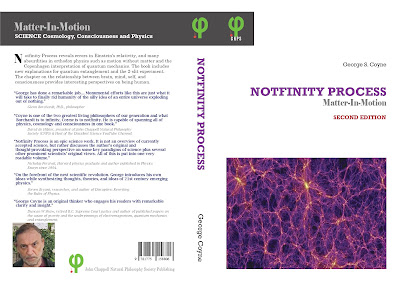PSI Blog 20210726 The switch from finity to infinity
Two questions from George
Coyne win the prize for this week:
“Glenn,
Do you recall when you
discovered that there was no finite universe?
In my own case, I do not
remember what age I was. I am just glad I came up with the realization that
there is a notfinity process of matter-in-motion— which led to the title of my
book, Notfinity Process— in place of a concept of the universe as an object.”
[GB: Thanks George. I have
been asked that many times. I keep half-way decent notes, so it seems to have
occurred before May 29, 1978. Before that, I was a “Big Banger” like almost all
scientists were at the time. Of course, I got a “C” in Physics
1a in 1962 when I had so much difficulty in believing there were 4 dimensions
as taught by our regressive physics prof at UW. Madison. Summer semester I took
Physics 1b from an 83-yr old prof who taught us the last half of Sears and
Zemansky, which was mostly Newtonian. I got an A. The lesson for me was: It is
extremely difficult to learn much of anything if you don’t agree with the basic
assumptions being espoused.
Later, in a soil science
course taught by my Quaker prof, I was assigned to read Whitehead’s “Science
and the Modern World.” This I pretty much could not make heads or tails of,
thinking I was too dumb to understand philosophy. Much later, my reread showed
how much of a mess it was, being an adoration of regressive physics and its religious
assumptions.
I never could get the hang of
the universe exploding out of nothing. In early 1978 I remember my reformist
attempt to imagine photons leaving the edge of the universe to combine to form
matter once again—anything to handle the supposed universal expansion into the perfectly
empty space that surrounded the supposed finite universe. That attempt used my
belief in Euclidean dimensions even though it also used Einstein’s magical
massless photon concept I was yet to examine.
To see more about my
conversion be sure to read the details, particularly about the discovery of
univironmental determinism, in:
PSI
Blog 20190501 The Discovery of Infinity ]
“What effect do you think
this way of viewing reality will have on scientific progress once it is adopted
by the majority of scientists?”
[GB: The neat thing about
science is that it is univironmental: Whatever we think about the universe
continually must be adjusted by our experiences with it. Collectively, these
experiences only can increase in number and intensity. That is why science is
progressive. Sure, there are regressive periods like the one engendered by
relativity, but that was only one century—nothing like the 10 centuries
comprising the Dark Ages.
True, most scientists, like
most folks, get to experiment with and observe only tiny bits of the universe.
To consider all of the observable portion is a hugh task, as I reiterated in "The
Scientific Worldview." Undergoing the Last Cosmological Revolution will be
a momentous turning point for humanity. Imagine: No Big Bang, no beginning, no
ending, no heaven, no hell. The contradictions resulting from the philosophy
underlying those dreams and imaginings continue to pileup. But, as always, the truth will prevail. The removal of contradictions is as inexorable
as their production.]
